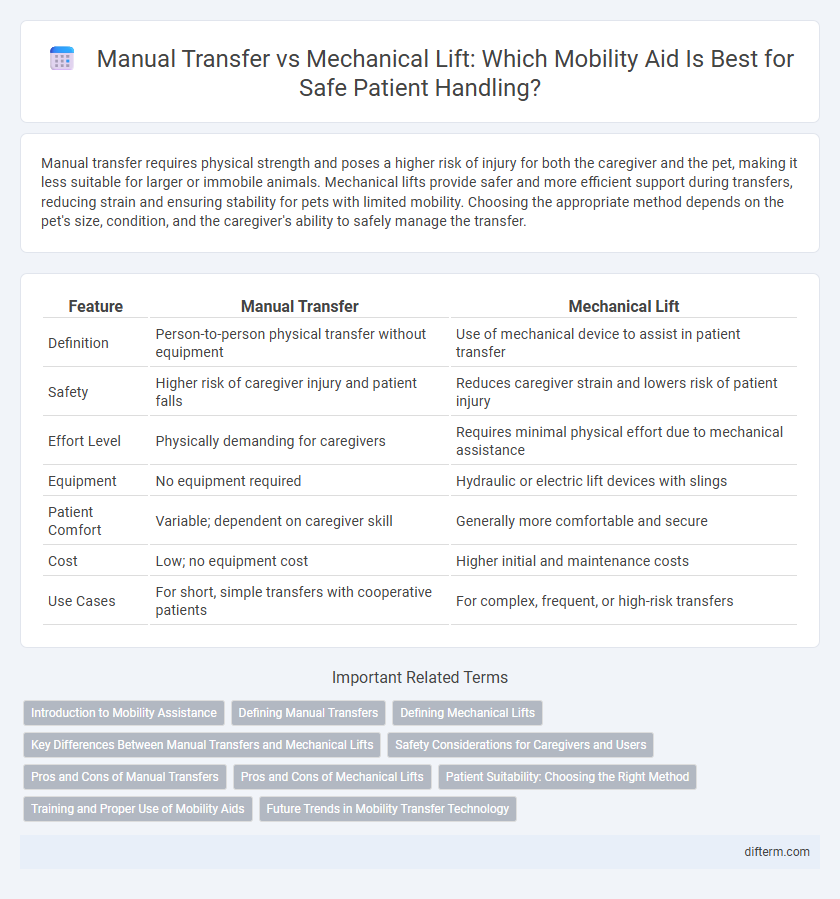Manual transfer requires physical strength and poses a higher risk of injury for both the caregiver and the pet, making it less suitable for larger or immobile animals. Mechanical lifts provide safer and more efficient support during transfers, reducing strain and ensuring stability for pets with limited mobility. Choosing the appropriate method depends on the pet's size, condition, and the caregiver's ability to safely manage the transfer.
Table of Comparison
| Feature | Manual Transfer | Mechanical Lift |
|---|---|---|
| Definition | Person-to-person physical transfer without equipment | Use of mechanical device to assist in patient transfer |
| Safety | Higher risk of caregiver injury and patient falls | Reduces caregiver strain and lowers risk of patient injury |
| Effort Level | Physically demanding for caregivers | Requires minimal physical effort due to mechanical assistance |
| Equipment | No equipment required | Hydraulic or electric lift devices with slings |
| Patient Comfort | Variable; dependent on caregiver skill | Generally more comfortable and secure |
| Cost | Low; no equipment cost | Higher initial and maintenance costs |
| Use Cases | For short, simple transfers with cooperative patients | For complex, frequent, or high-risk transfers |
Introduction to Mobility Assistance
Manual transfer involves physically assisting a person by hand to move from one surface to another, relying heavily on caregiver strength and technique, often suited for short distances and cooperative individuals. Mechanical lifts utilize devices such as hydraulic or electric hoists designed to safely transfer individuals with limited mobility, reducing injury risks for both the caregiver and patient. Choosing between manual transfer and mechanical lift depends on factors like patient weight, physical condition, and safety requirements in mobility assistance.
Defining Manual Transfers
Manual transfers involve caregivers physically assisting individuals in mobility tasks such as moving from bed to wheelchair using hands-on support without mechanical aids. This method requires proper body mechanics and strength to ensure safe handling and minimize injury risk for both caregiver and patient. Manual transfers are typically preferred for patients with sufficient upper body strength and when quick or frequent transfers are necessary.
Defining Mechanical Lifts
Mechanical lifts are specialized devices designed to safely assist in transferring individuals with limited mobility, reducing the physical strain on caregivers. These lifts typically feature a harness or sling attached to a hydraulic or electric lifting mechanism, enabling smooth and controlled movements from bed to chair or wheelchair. Their use significantly decreases the risk of injury for both the patient and caregiver, promoting safer and more efficient mobility management.
Key Differences Between Manual Transfers and Mechanical Lifts
Manual transfers involve human assistance, relying on caregiver strength and technique to move patients, which can increase the risk of injury for both parties. Mechanical lifts use hydraulic or electric systems to safely lift and transfer patients, minimizing physical strain and enhancing stability during movement. Key differences include the level of physical effort required, safety protocols, and suitability for patients with varying mobility limitations.
Safety Considerations for Caregivers and Users
Manual transfer requires caregivers to use proper body mechanics to prevent musculoskeletal injuries, emphasizing the importance of training and physical strength. Mechanical lifts, such as Hoyer lifts, reduce physical strain and lower the risk of caregiver injury by using supportive harnesses and motorized assistance but require regular maintenance and user compliance for safe operation. Safety considerations for users include stability, comfort, and secure positioning to prevent falls or pressure injuries during transfers.
Pros and Cons of Manual Transfers
Manual transfers offer greater personal interaction and flexibility, allowing caregivers to adjust positioning in real-time and maintain closer physical contact with the patient. They require less equipment investment and can be faster for short or simple movements but pose higher risks of injury for caregivers due to physical strain. Limitations include reduced safety and comfort for heavier or less cooperative patients, making manual methods less suitable for frequent or complex transfers.
Pros and Cons of Mechanical Lifts
Mechanical lifts increase safety by reducing the risk of injury for both caregivers and patients during transfers, providing stable support through hydraulic or electric systems. They require less physical effort, making them ideal for heavy or immobile individuals, yet the equipment can be costly and may require regular maintenance and training for proper use. Limited accessibility in tight spaces and potential discomfort for some patients are notable drawbacks compared to manual transfers.
Patient Suitability: Choosing the Right Method
Manual transfer suits patients with partial weight-bearing ability and cognitive cooperation, allowing caregivers to use safe body mechanics during movement. Mechanical lifts are ideal for patients with limited mobility, high fall risk, or those who require complete support to prevent injury. Selecting the right method enhances safety, comfort, and efficiency based on patient strength, size, and mobility level.
Training and Proper Use of Mobility Aids
Effective training in manual transfer techniques reduces the risk of injury for both caregivers and patients, emphasizing correct body mechanics and clear communication. Proper use of mechanical lifts requires comprehensive instruction on equipment operation, regular maintenance, and safety protocols to ensure secure transfers. Consistent education on mobility aids enhances confidence, promotes independence, and optimizes patient safety during transfers.
Future Trends in Mobility Transfer Technology
Future trends in mobility transfer technology emphasize integration of AI-powered mechanical lifts with sensors for personalized, safe, and efficient transfers. Emerging smart materials and robotics improve adaptability and user comfort during both manual transfers and lift-assisted movements. Continuous advancements focus on reducing caregiver strain and enhancing autonomy for individuals with mobility challenges.
Manual transfer vs Mechanical lift Infographic

 difterm.com
difterm.com